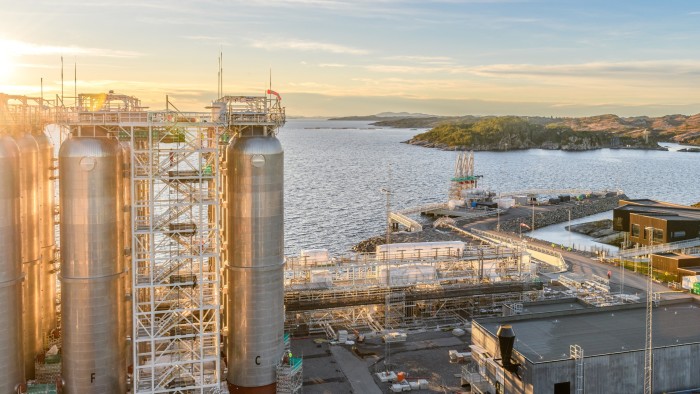Carbon capture faces high cost hurdles

Roula Khalaf, Editor of the FT, selects her favourite stories in this weekly newsletter.
The hope of seeing the Northern Lights has long drawn tourists to Norway, but a Norwegian carbon capture and storage (CCS) project of the same name is now attracting plenty of interest of its own.
Northern Lights, a joint venture between oil companies Shell, Equinor and TotalEnergies, has welcomed 6,000 visitors — including politicians, industry leaders and climate campaigners — to its site in Øygarden, near Bergen, in western Norway, since construction began in 2021. It will be the world’s first system offering cross-border transportation and storage of clients’ carbon dioxide emissions when it launches next year.
The process involves capturing carbon from industrial or power plant emissions and injecting it into depleted oil wells or aquifers. Oil and gas companies have sought to play a leading role in developing CCS technology, but some accuse them of using it as a means to justify continued fossil fuel extraction. The International Energy Agency criticised the industry’s “excessive expectations and reliance on” the technology just last week — saying it was “not a way to retain the status quo”.
Northern Lights says it will offer a comprehensive service to carbon emitters. “We compare it with waste handling: you put your trash on the kerb and we come and pick it up,” explains Børre Jacobsen, the venture’s managing director. It has signed deals to handle a small proportion of global emissions from Yara, a Norwegian fertiliser producer, and Heidelberg Materials, a German cement manufacturer.
Heavily polluting industries are betting on CCS technology to cut their greenhouse gas emissions. But, despite rapid growth in the sector, the technologies remain expensive, and have not yet been proven at the scale needed to abate emissions fully.

This article is part of an FT special report on Managing Climate Change
Total investment in CCS projects reached a record $3bn in 2022, according to the IEA. However, the organisation says: “current [CCS] policies are wholly insufficient to support outcomes that match government net zero emissions pledges.” Based on present plans, 115mn tonnes of CO₂ will be captured in 2030, compared with 40mn tonnes now. To reach net zero emissions, 1bn tonnes of CO₂ will need to be captured by the end of the decade, the IEA says.
While Jacobsen expects progress by 2030, he notes that CCS will face technical barriers, as with any developing technology. “Most timelines will probably slip a little bit, by a year or two,” he says.
It is set to be a big topic at the COP28 summit this month. COP president-designate Sultan al-Jaber, who is also chief executive of Abu Dhabi state oil company Adnoc, has said the world must “get serious about carbon capture technologies” if it is to reduce industrial emissions.
Experts say mechanical carbon removal methods are likely to be a necessary part of tackling climate change but that governments should focus efforts on reducing current greenhouse gas emissions through other means, such as rolling out renewables, or increasing energy efficiency.
“We should be trying to get rid of the CO₂ emissions without applying CCS and, once we’ve got to the stage where we can’t really substitute, then we’ve got to apply it,” says Paul Fennell, professor of clean energy at Imperial College London. “It’s uniquely important for decarbonising some very challenging industries, particularly cement, iron and steel.”
The IEA has said there should be no new oil and gas drilled if the world is to meet its goal of net zero emissions by 2050. But industry executives reject the idea that the technology is a means to justify further oil and gas exploration.
“CCS has nothing to do with the continuation of production of hydrocarbons,” says Guido Brusco, chief operating officer of natural resources at Italian energy group Eni, which is active in several CCS projects in the UK, Italy and elsewhere. However, the UK government has announced both new oil and gas licences in the North Sea and £20bn in funding for carbon capture and storage. “I’m annoyed that the government is deliberately trying to conflate CCS with new oil and gas,” Fennell says.
Brusco expects Eni to avoid the delays that have plagued some projects by pumping CO₂ into unused oil and gas reservoirs, rather than aquifers. US oil major Chevron’s CCS site in Gorgon, Australia, was delayed by excess water in its reservoirs. The company spent $3.2bn building a CCS system to accompany a $54bn natural gas project, but the project has missed a target of capturing and storing 80 per cent of the CO₂ it produces for a seventh consecutive year.
This month, Eimear Bonner, chief technology officer at Chevron, told the FT the company is working to remove the excess water, saying the technology is working “very well”. But Chevron stored just a third of the CO₂ it captured in the year to June 2023. Missing targets has cost the group tens of millions of dollars in carbon offsets.
In the UK, CCS projects are not set to be in operation until 2025, with questions remaining over its commercial viability. “The rate of investment has been slow, unsurprisingly. It’s not directly revenue generating — you’ve got to create a market in terms of carbon credits,” notes Jon Gluyas, professor of geoenergy, carbon capture and storage at Durham University.
More government support to carbon prices is needed to make polluting without capturing emissions more expensive, says Jacobsen, and businesses should be rewarded for using the system. Longer term, “you need to get away from subsidies if this is to take off. Will there be a premium [paid to businesses using carbon capture]? If big corporations are serious, they need to start buying carbon-free materials.”

Comments